Joe wraps a rope several time around the barrel, and attaches the end of the rope to a bucket of mass m = 5 kg. The bucket hangs motionless H = 2.5 m above the ground because Joe is holding onto the barrel.
At time t = 0, Joe releases the barrel. The bucket starts to fall downwards, pulling on the rope and causing the barrel to spin. As the bucket falls, the barrel spins faster and faster.
How long does it take the bucket to reach the ground?
- the answer
- detailed solution: part I part II part III
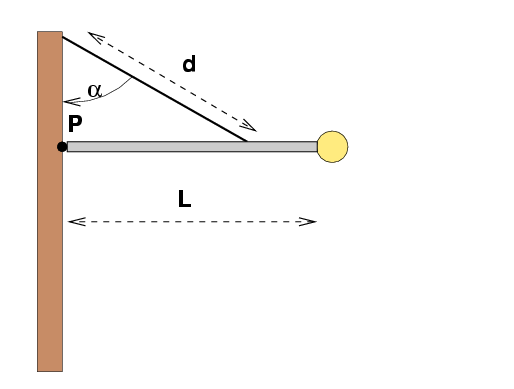
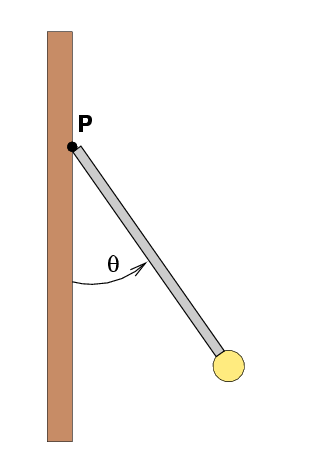
- When the flagpole is in equilibrium, what is the tension in the wire?
- When the pole has swung so that there is an angle theta = 20 degrees remaining between it and the wall, what is the pole's angular acceleration around the hinge?
- Is the motion of the pole an example of simple harmonic motion?
- Just before the pole slams into the wall, what is the linear speed of the golden ball?
The wire breaks! The pole starts to swing downwards around the hinge without friction of any kind.
- the answers
- detailed solution: part I part II part III part IV
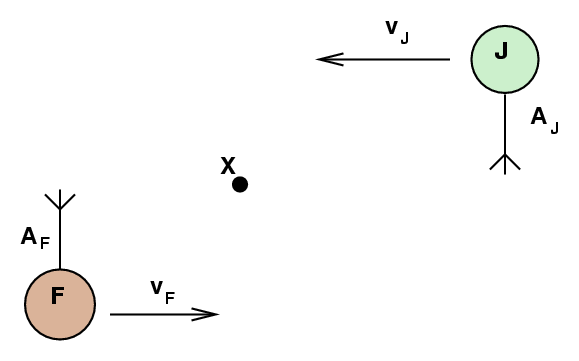
- Jane has initial speed 4 m/s. What speed should Fred have?
- What is their initial angular momentum around point "X"?
- What is their moment of inertia around point "X"?
- What is their angular speed?
- What are their linear speeds?
- What is their rotational KE?
- What is their angular speed now?
- What is their rotational KE now?
It works! They are now holding hands and spinning around point "X", Jane AJ from the center and Fred AF from the center.
To end their program, they pull each other close, until their centers of mass are only bJ = 0.28 meters and bF = 0.21 meters from point "X".
- the answers
- detailed solution: part I part II part III
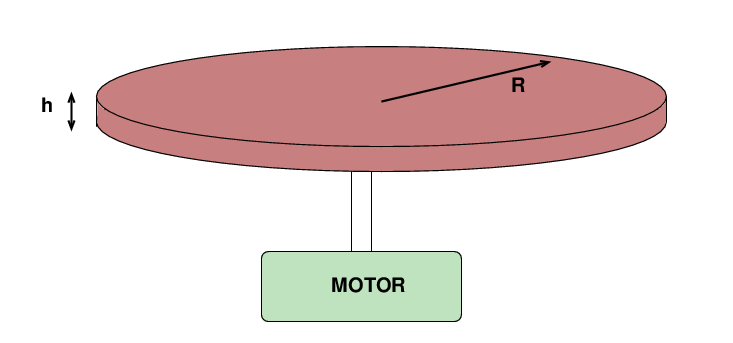
Polly turns on the electric motor which is attached to her wheel. It applies a torque which increases gradually with time, according to the equation

where time t is measured in seconds.
- What is the moment of inertia of the wheel?
- What is the torque at the time t = 2 s?
- What is the angular acceleration of the wheel at time t = 2 s ?
- What is the angular velocity of the wheel at time t = 2 s ?
- What is the instantaneous power delivered by the motor to the wheel at time t = 2 s ?
- detailed solution: two page solution (PDF)
The pterodactyl opens its mouth wide, creating a circular maw of diameter D = 0.18 m. As it coasts into the swarm, it gulps down huge numbers of the insects. After a short time, its speed has been reduced to v' = 0.8*v = 8 m/s.
(Assume that the pterodactyl is not flapping its wings this entire time, and ignore air resistance)
- What mass of locusts has the pterodactyl engulfed at this point?
- How far into the swarm has it flown?
- detailed solution: two page solution (PDF)
Joe fires his trusty M16 at the incoming object. A bullet from his 5.56x45mm NATO cartridge (m = 4 grams) flies at w = 940 m/s toward its target, passes through it, and exits the fruit with a speed of w' = 600 m/s, still going in the same direction.
- What is the fruit's velocity now?
- How many bullets must Joe fire to stop the durian?
(For fun)
- Does Joe have time to fire that many shots?
- What extra danger does Joe face due to his blowing holes through the durian?
- detailed solution: two page solution (PDF)
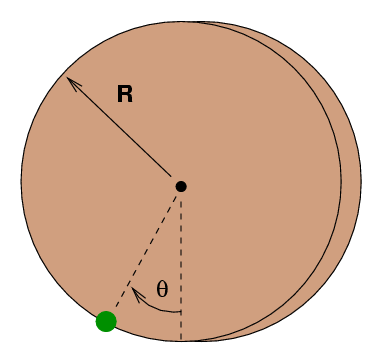
Fred now turns the disk a small distance theta from its resting position and releases it. The disk starts to oscillate back and forth.
- Show that the motion of the disk is SHM.
- What is the period of the motion?
- the answers
- detailed solution: part I part II